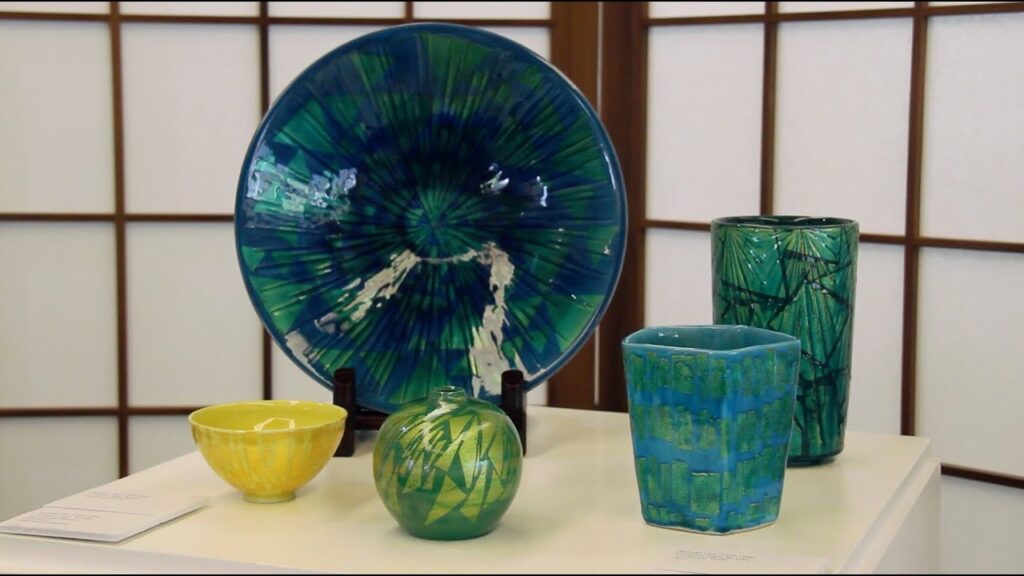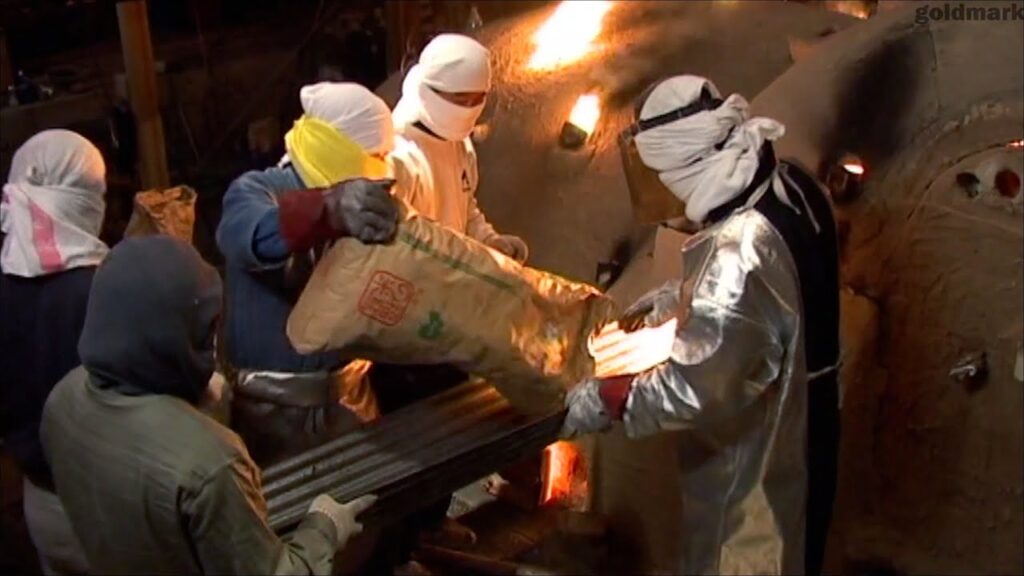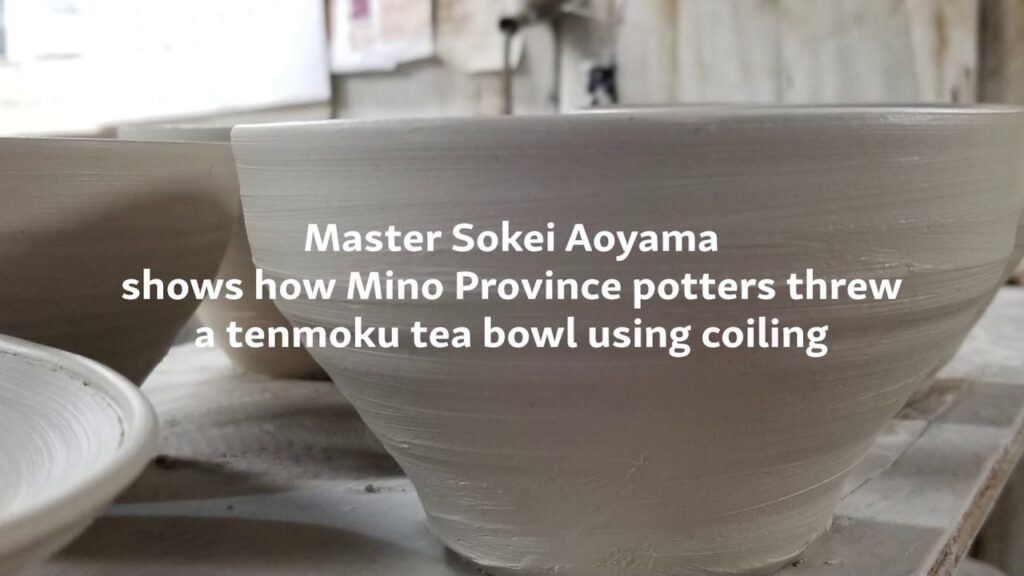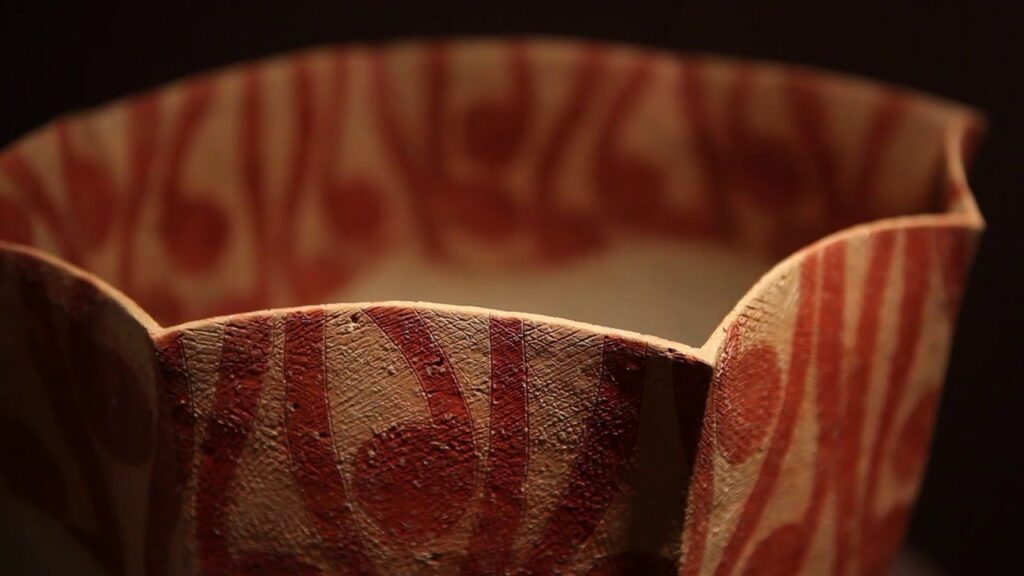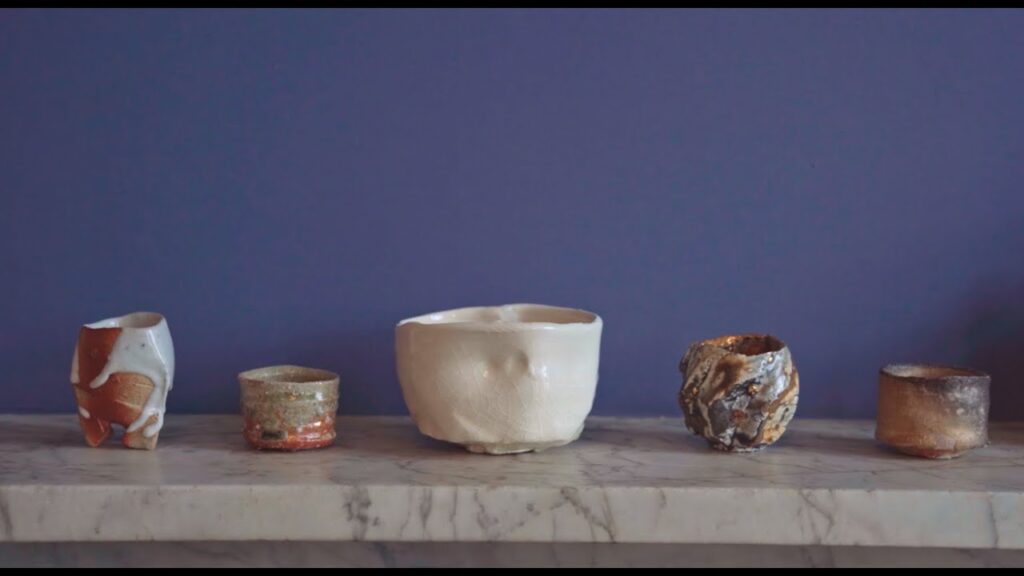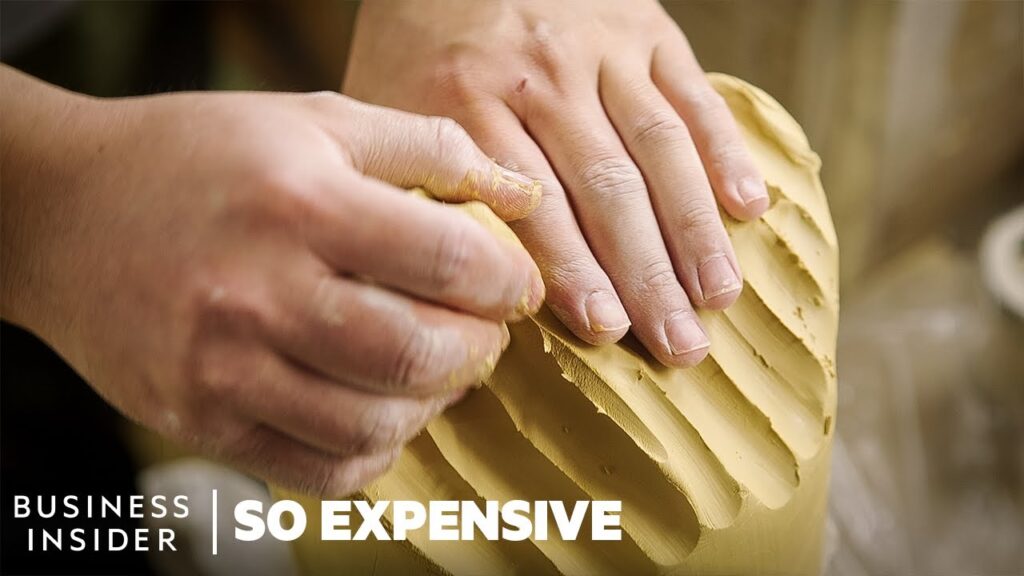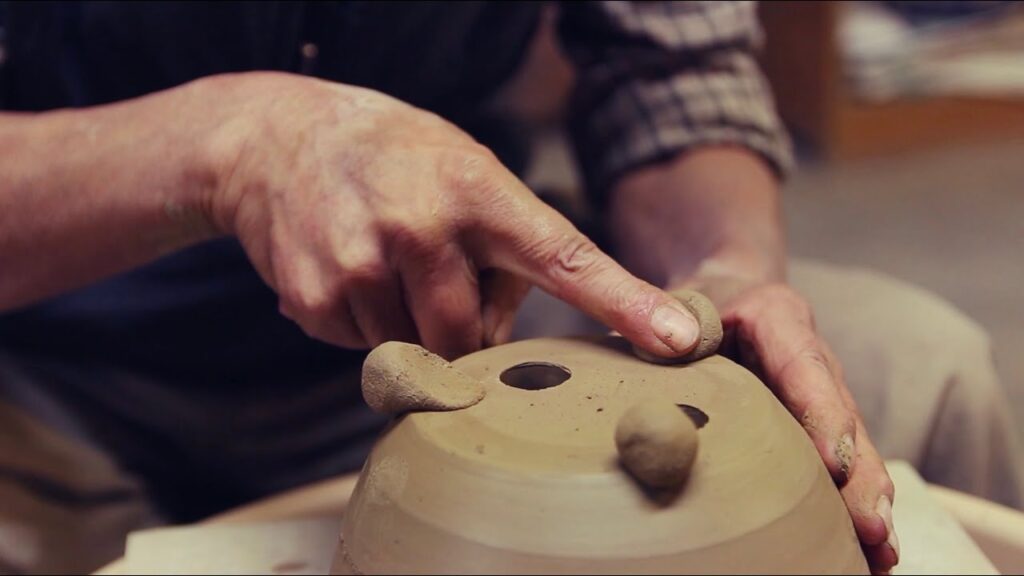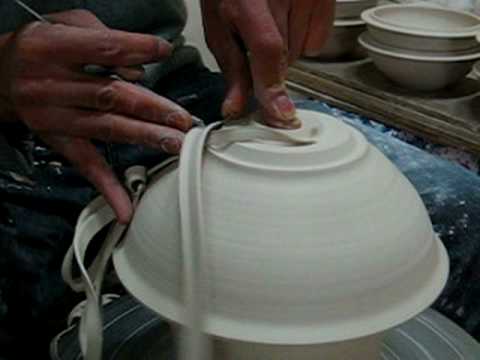Japan
Ken Matsuzaki: “Elemental” feature film about Japanese potter
Ken Matsuzaki is a Japanese potter working from Mashiko who enjoys an international reputation. He was apprenticed to the late Tatsuzo Shimaoka (National Living Treasure) who in turn had been apprenticed to Shoji Hamada. Matsuzki's work can be seen in some of the world's most prestigious private collections.
This 45 minute film shows him throwing in his workshop and features unique footage of him firing his Anagama kiln, with the help of British potter Phil Rogers who commentates on the process. The film ends with Matsuzaki's 2007 major exhibition of pots at the Goldmark Gallery in Uppingham, Rutland. You can visit us online at
To view latest work by Matsuzaki visit his goldmark website here:
You can buy a copy of this film on DVD for just £10 click here:
Biography – Ken Matsuzaki was born in 1950 in Tokyo. Growing up Matsuzaki's life was filled with art and culture and his family's influence began to show when, around the age of 16, Matsuzaki developed an interest in ceramics. In 1972, after graduating from Tamagawa University's College of Arts, he began a 3 year apprenticeship with (National Living Treasure) Tatsuzo Shimaoka.
Nearing the end of his apprenticeship Matsuzaki asked Shimaoka if he would consider extending it for another 2 years, whilst he learned to develop his own style, and began creating his own motifs and palette of glazes that he would use for the next 15 years. Today, Matsuzaki has exhibited widely in Japan, America and the UK and his work is held in major galleries worldwide.
What is Goldmark?
A family business started by Mike Goldmark, we've been selling art from the Goldmark Gallery in Uppingham, UK for over 40 years and hold over 50,000 items in stock. Explore a wide range of the very best art and ceramics available to you through our website where you'll also find scholarship pages, books, online catalogues and even GoldmarkTV! Enjoy your visit here:
A Japanese pottery master throws a classic tenmoku tea bowl
FOLLOW-UP VIDEO here:
Pottery master Sokei Aoyama has spent his life researching ancient techniques and reproducing pottery. In this video, he throws a tenmoku tea bowl using the same technique as the craftsmen of ancient Japan, as far back as the Heian period. Aoyama-sensei is based in Tajimi, Gifu Prefecture, and has traced the production of the white tenmoku (Japanese: shiro tenmoku) to the town of Onada. This pottery is a very rare example of ceramics not having originated in China or Korea, but being unique to Japan.
Contemporary Japanese Ceramics from the Collection of Gordon Brodfuehrer
Nature, Tradition and Innovation
Contemporary Japanese Ceramics from the Collection of Gordon Brodfuehrer
This exhibition explores the evolution of contemporary Japanese ceramics through the work of many artists and a variety of forms, from tea bowls and noodle cups to stunning vases and robust platters. Strong and sculptural, these ceramic pieces also reveal an earthy beauty through abstract forms, soft colors and pools of glaze. These organic objects come from kilns throughout the regions of Japan, and their clear connection to nature will be enhanced with large scale photographs of Japanese landscapes and natural elements.
On view Jun 2, 2012 – Jan 13, 2013 at the Mingei International Museum
Video Produced by Balboa Park Online Collaborative
Encounters with Japan: Collecting Japanese ceramics
Tim Warner-Johnson has been building an interesting collection of Japanese ceramics over the last few years, with limited budget and without going to Japan. His inspiring story shows what can be achieved with passion and focus. He discusses some of his favourite pieces with Sophie.
Tim and Sophie looked at works by the following artists (in order of appearance on the video):
Elspeth Owen (b. 1938)
The very first piece of ceramic acquired by Tim was by Elspeth Owen, a British studio potter active in Cambridgeshire.
Yui Tsujimura (b. 1975)
Living and working in Nara, he is the first son of famed potter Shiro Tsujimura. His signature ash-glazed pieces are fired in a kiln he built for himself in 2000.
Shiro Tsujimura (b. 1947)
One of the leading ceramic artists in Japan today, he lives in the mountains outside of Nara. Self-taught, he creates powerful functional vessels in a wide-ranging repertoire. He shows a particular fondness for a technique known as kohiki in which a vessel is dipped, either partially or in its entirety, in white slip.
Takuro Kuwata (b. 1981)
Living in Gifu Prefecture, Kuwata is best known for his contemporary take on the venerable Japanese tea bowl. Breaking away from traditional aesthetic, he adopts a strong palette, glistening glazes and fractured forms.
Ryuichi Kakurezaki (b. 1950)
Born in Nagasaki, he now lives in Bizen where he has developed his own original style. His sharply cut forms and three-legged vessels have become his trademark.
Kazu Yamada (b. 1954)
Hailing from a family of ceramicists, he produces mostly Mino wares and is especially admired for his mastery of various shino glazes, including the striking ‘dancing fire’ glaze.
Toru Ichikawa (b. 1973)
An apprentice of Ryuichi Kakurezaki, Ichikawa established his own kiln in Bizen in 2015. He creates beguiling, dynamic and colourful ceramics that have earned him a fast-growing popularity.
Ryoji Koie (1938-2020)
One of the most influential figures in the world of Japanese ceramics, Koie was a playful and provocative artist. His very diverse output shows his taste for experimentation and his inclination for breaking the rules.
Why Porcelain Is So Expensive | So Expensive | Business Insider
Handmade ceramics aren't cheap, but porcelain is often even more expensive. Compared to other ceramics, porcelain is non-porous, white, and translucent. The secret to these differences is in the clay. But even for experienced potters, porcelain can be challenging to work with. So how is porcelain made and why is it so expensive?
MORE SO EXPENSIVE VIDEOS:
Why Moroccan Zellige Tiles Are So Expensive | So Expensive
Why Japanese Denim Is So Expensive | So Expensive
Why French Leavers Lace Is So Expensive | So Expensive
——————————————————
#Porcelain #SoExpensive #BusinessInsider
Business Insider tells you all you need to know about business, finance, tech, retail, and more.
Visit us at:
Subscribe:
BI on Facebook:
BI on Instagram:
BI on Twitter:
BI on Snapchat:
Boot Camp on Snapchat:
Why Porcelain Is So Expensive | So Expensive | Business Insider
The Clay Masters of Tokoname
Meet the Clay Masters of Tokoname in this mini-documentary on Bonsai ceramics!
Tokoname is one of the six famous old kilns of Japan, producing tea pots, sewer pipes and… Bonsai Pots. Though Tokoname was famous for its clay (Tokoname literally means "Always smooth"), much of that has ran out and what remains are highly skilled craftsman, with a reputation for quality Bonsai containers, both glazed and unglazed.
Invited by the Tokoname association, we shot this documentary on the true craftsmanship of the potters. Focusing on the process of creating a Bonsai pot, we filmed six artists in their ateliers.
The stars of the film:
Tatsuhiro Tanaka (Clay Atelier)
Katsushi Kataoka (Reiho, Seizan Toen)
Kazuhiro Watanabe (Ikko, Kanesho Seitosho)
Kakuyuki Watanabe (Kakuzan toen)
Katsuichi Shibata (Shibakatsu en)
Hidemi Kataoka (Shuuhou, Yoshimura toen)
And the process of creating Bonsai pots:
Step 1: Preparing the clay
At the Atelier of Tokoname clay they import, mix, purify and distribute all the clay for the all potters in Tokoname. For different types of pottery, there are different types of clay and the potters can customize their own mixture for the best characteristics.
Once the clay is at the potter, it will be kneaded by both hand and machine to enable the potter to work with it. Normally a potter uses a machine to make the clay more soft and then knead it in the right shape.
Next, there are three different ways to shape a pot. We'll explain the shaping with a mould first and after that describe how the wheel and manual methods work.
Step 2a: Shaping with a mould
The slab of clay is created by kneading the clay thoroughly and then creating thin layers by running a thin steel wire across the clay.
The slab is then rolled onto a pipe to transport it to the mould.
Finally, the slab is then pushed and shaped into the mould using a sand bag. Excess clay on the inside is now removed using a spatula, to make sure the thickness of the clay is uniform. The moulded pot then needs to dry for a day, before the mould can be removed. Usually this is the moment to add the stamp on the bottom of the pot, as well as creating holes for drainage. Finally, with some moulds the rim also needs to be added manually.
Step 2b: Shaping with a wheel
Using the wheel is probably the method that we always think of when talking about pottery. The potters show incredible craftsmanship when creating the perfect shape for the bonsai pot.
While the feet of the pot are automatically created when using a mould, the potter that uses the wheel as a shaping method, needs to create this separately (usually after one day of drying first).
Step 2c: Shaping with clay slabs
Not all pots can be made using moulds or wheels. As not all can be similar in shape and not all are round. Some potters rather form the bonsai pots themselves using slabs that they cut out themselves. This enables them to make one of a kind pots that are exactly designed to their customer’s wishes. Usually the body of the pot is designed first and after a few hours drying the rim is added, and again a few hours later the feet can be created.
Step 3: Finishing and drying
Water finishing. To smoothen the surface and edges of the pot, the craftsmen use all kinds of cloths and cards that they dip in water.
Drying. Drying makes sure that the pots stay in the right shape when being fired later. Drying can take between 1-3 days time depending on the size of the pot. On this photo several glazed pots are drying, almost ready to be fired.
Step 4: Glazing
Some pots are glazed, mostly to suit Deciduous or broadleaf evergreen trees. The pot is dipped into a basin of glaze, after which it is left to dry for about a day before being fired. Sometimes a second glazing is added and the pot would be fired again.
Step 5: Finishing and firing
Both the surface and the edges are polished and smoothened during the drying process, right before the firing.
After one day of drying the potter can add their own brand mark by either scribbling or pressing their name on the bottom of the pot.
The kiln is then packed with pots and over the course of about 30 hours heated to 1180 degrees Celsius, and cooled down again.
This film is a cooperation of Bonsai Empire with the Japan Patent Office (JPO) and the Japan External Trade Organization (JETRO).
Music, in order of playing: Chat roulette, Avert your Eyes, Water Lillies, 1.42, Still (Hiatus), Mana Two, Lullaby, Sixteen Twenty Five.
More information:
Korean Porcelain Trimming Skills w/ Moon Byeong Sik
On my recent visit to S. Korea I was able to connect with Moon Byeong Sik, a porcelain potter I had met a few years back. This was my first visit to his studio and he was gracious enough to offer me a wheel and some clay and we both threw pots and compared techniques. While neither of us speak too much of each others language, we were able to use the clay as a prop for conversation.
Ancient figurines (i.e. Haniwa) surround Shoufutago Kofun in Gunma, Japan – 小二子古墳
This is another kofun found within Omuro Park (大室公園) in Maebashi, Gunma.
Although it's small for a keyhole kofun (in Japanese 前方後円墳 Zenpōkōenfun) at 38m, the abundance and variety of haniwa (the statues) make this one of the better kofun I've seen. Yes the haniwa are replicas, but they are arranged in the kind of way that they would have been all those 1500 years ago. Very cool.
More info here :
*********************************************
Q: What am I watching here ?
A: You are watching footage of a "kofun/古墳" – kofun are tombs in Japan that were created during the Kofun Period (roughly between the 3rd and 7th Century AD) – this era was preceded by the Jomon and Yayoi periods, and followed by Asuka, Nara and so on. These tombs were built as burial chambers for people from Japanese imperial families and other people of higher status in society during those days. The most well-known and generally largest tombs are found around Kyoto and Osaka, but they are found all over Kansai, Kanto, Tohoku etc., and even in other parts of Japan such as Shikoku and Kyushu. Figures vary greatly, but some sources state there are over 160000 thousand of these kofun in Japan. At times you will see haniwa on and around kofun – haniwa are terracotta figures which were made in various shapes, including being formed as people and animals.
Have a read of the the Wikipedia article for more information :
I also have a Facebook page where I post these videos. Feel free to contact me via that page if you want to connect regarding anything about kofun, particularly their promotion to tourists to Japan. Ideally I'd like to build a kofun appreciation community of sorts, but that is just a dream right now –
A Haniwa Model of a Horse from 6th-Century Japan
This haniwa clay model of a horse from 6th-century Japan would have been buried in a tomb on ‘a very grand scale’, explains Japanese Art specialist Mark Hinton.
Find out more at
The decoration and detailing suggest it would have been made for a ‘very high-ranking person’, with tombs for such people often being ‘similar in size to a football pitch’.
Haniwa of armoured warriors and horses of the 5th and 6th century A.D. indicate the military power of the ancestors of the imperial line, and show that the horse must have played a major role in the unification struggles and the rise of the Yamato clan.
Although archaeology tells us that there were wild horses in Japan long before the Kofun period when this was made, it is believed that they had never previously been domesticated. The contents of tombs attest that horses and riding accoutrements were brought to Japan from China and Korea around the end of the 4th and the beginning of the 5th century.
‘I think it is a very imposing and rather haunting creature,’ says Hinton of this impressive highlight from the Art of Japan sale on 8 December in London. ‘It gives us an insight into an extraordinary period in the pre-history of Japan.’

